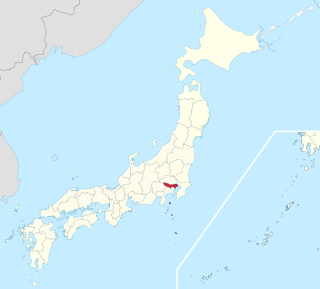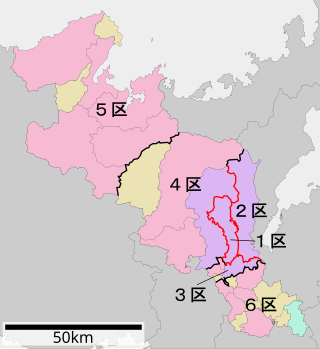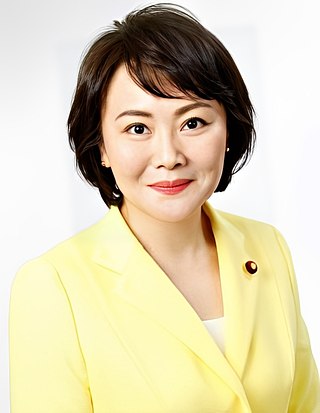
The Okinawa at-large district is a constituency of the House of Councillors in the Diet of Japan. It consists of the entire prefecture of Okinawa and was created in 1970 following the agreement between US president Richard Nixon and prime minister Eisaku Satō on restoration of Japanese sovereignty over the Ryūkyū islands. Okinawa is represented by two Councillors electing one every three years.

Tokyo at-large district is an electoral district of the House of Councillors in the National Diet, the national legislature of Japan. The district was created in 1947 by the new Constitution of Japan and sent 8 members to the House from 1947 until 2007. From 2007 until 2016, this district sent 10 members to the House, and from 2016 onwards, the district has sent 12 councillors to the House, making it by far the largest constituency in the House of Councillors.

Tochigi At-Large District is a multi-member district of the House of Councillors in the Diet of Japan. It consists of Tochigi Prefecture and elects two Councillors, one per election.

The Hokkaido at-large district is a constituency of the House of Councillors in the Diet of Japan. It consists of the prefecture (dō) of Hokkai[dō] and is represented by six Councillors electing three at a time every three years by single non-transferable vote for six-year terms. In the election period from 2019 to 2022, Hokkaido's Councillors are :

The Tokyo 3rd district is a constituency of the House of Representatives in the Diet of Japan. It is located in Tokyo and encompasses Shinagawa ward and several outlying islands that belong to the Tokyo Metropolis.
Tokyo 2nd district was a constituency of the House of Representatives in the Diet of Japan. Between 1947 and 1993 it elected three, later five representatives by single non-transferable vote. It initially consisted of Shinagawa and Ōta in Eastern mainland Tokyo and, following their return from US military administration, Tokyo's Izu and Ogasawara islands. Since the election of 1996, the area forms the new single-member 3rd district.

The Nagasaki at-large district is a constituency of the House of Councillors in the Diet of Japan. It consists of Nagasaki Prefecture and elects two Councillors, one every three years by a first-past-the-post system for a six-year term. In the first election in 1947, Nagasaki like all districts used single non-transferable vote to elect both its Councillors in one election. Similar to other small, rural Kyushu prefectures, it is a "conservative kingdom" in favor of the LDP. Since the Democratic Party folded, LDP candidates have consistently won with over 50% of the vote.

Kyōto 3rd district is a constituency of the House of Representatives in the Diet of Japan. It is located in South central Kyoto and consists of Kyoto city's Fushimi ward, the cities of Mukō and Nagaokakyō and the town of Ōyamazaki. As of 2012, 345,260 eligible voters were registered in the district.
The Tokyo counties district was an electoral district for the House of Representatives in the Imperial Diet of Japan. Between 1902 and 1917, it eletected five representatives by single non-transferable vote. It was located in Tokyo and consisted of all counties (gun) of the prefecture and the Izu and Ogasawara islands, in other words all parts of Tokyo that did not belong to Tokyo city. The counties were: Ebara County, Toyotama County, Kita-Toshima County, Minami-Adachi County, Minami-Katsushika County, Kita-Tama County, Minami-Tama County and Nishi-Tama County; the island communities hadn't yet been organized into modern municipalities.

Hokkaidō 1st district is a single-member constituency of the House of Representatives, the lower house of the national Diet of Japan. It is located in Sapporo, the prefectural capital of Hokkaido. In 2017, its border were redrawn and it now consists of Sapporo's Chūō ("Centre") and Minami ("South") wards, a portion of Nishi ("West") ward as well as a small part of Kita ("North") ward.

Miki Yamada is a former Japanese politician and member of the House of Representatives. She is a member of the Liberal Democratic Party.

Kanagawa 8th district or more formally the "8th district of Kanagawa Prefecture" is a single-member electoral district for the House of Representatives, the lower house of the National Diet of Japan. It is located in northwestern Yokohama the capital of Kanagawa prefecture. The district covers the wards of Midori and Aoba. As of 2023, the district had 410,262 eligible voters.
Hyogo 8th district, also referred to as Hyōgo hachi-ku (兵庫8区), is a constituency of the House of Representatives in the Diet of Japan. It is located in southwestern Hyōgo and consists of the city of Amagasaki. As of September 2015, 379,207 eligible voters were registered in the district. It is one of the 48 districts in the Kansai region that form the Kinki proportional representation block.
Hyogo 2nd district, also referred to as Hyōgo ni-ku (兵庫2区), is a constituency of the House of Representatives in the Diet of Japan located in southwestern Hyogo Prefecture. The district consists of the Hyōgo, Kita and Nagata wards of Kobe and, after redistricting in 2017, a part of Nishinomiya. As of September 2015, 357,643 eligible voters were registered in the district. It is one of the 48 districts in the Kansai region that form the Kinki proportional representation block.
Hyogo 1st district, also referred to as Hyogo No.1 district and Hyōgo ichi-ku (兵庫1区) in Japanese, is a constituency of the House of Representatives in the national Diet of Japan. It is located in southwestern Hyogo Prefecture and consists of the Chūō, Nada and Higashinada wards of Kobe. As of September 2015, 378,434 eligible voters were registered in the district. It is one of the 48 districts in the Kansai region that form the Kinki proportional representation block.

Hokkaidō 11th district is a single-member constituency of the House of Representatives, the lower house of the national Diet of Japan. It is located in southeastern Hokkaidō and consists of the city of Obihiro and the surrounding Tokachi Subprefecture. As of 2016, 291,852 eligible voters were registered in the district. The district is the country's second largest in terms of area after the neighbouring 12th district.

Tokyo 7th district is a constituency of the House of Representatives in the Diet of Japan. The district is in central Tokyo and encompasses the entire wards of Shibuya and Minato.

Yamaguchi 3rd district (山口県第3区) is a single-member electoral district for the House of Representatives, the lower house of the National Diet of Japan. It is located in Western Yamaguchi Prefecture and includes Shimonoseki the largest city in the prefecture.
Akimasa Suzuki is a Japanese politician who is the Mayor of Ōta, a Special ward of Tokyo, since April 2023. A former member of the Tokyo Metropolitan Assembly, Suzuki was chairman of the Special Committee on Budget and Chairman of the General Affairs Committee.